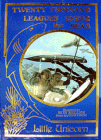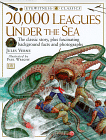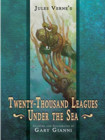|
|
|
||
|
|
|
||
|
Twenty Thousand Leagues under the Sea
by Jules Verne |
|
|
Seeing the 1916 silent film in the mid 90s rekindled my interest in this book. I'd started reading a nicely bound classic version before stumbling onto The Annotated Jules Verne - Twenty Thousand Leagues under the Sea by Walter James Miller in a used bookstore. From this volume I learned that the original English translator, Mercier Lewis, cut a quarter of Verne's text, leaving the English-speaking world with a weak, flawed version of the novel, destined to be considered merely a work of juvenile fiction. The worst part of the crime is that it's difficult to rectify today. The flawed version is in the public domain, so many a publisher will choose it, rather than an accurate new translation, because it is much cheaper to get into print. Complete versions of the book are available but some are comparatively expensive and you probably won't find them in your local bookstore. With patience you may find an out-of-print or used volume with Bookfinder.com, a combination search engine used by hundreds of used and rare booksellers around the world. |
|
|
|
Note that mass booksellers often do not
distinguish between different translations and editions. My links are to the specific
editions listed.
I have mini reviews and comparisons of
some complete editions |
These in-print volumes are available at amazon.com. Click on the links for information about purchasing them. I like the Naval Institute Press edition, translated by Walter James Miller and Frederick Paul Walter. The volume is well illustrated with some of the original woodcuts and includes interesting background material. The more recent Oxford's World's Classics edition, translated by William Butcher, has some fascinating notes about Verne's early manuscripts, and is quite inexpensive. Butcher has updated this translation and notes. The 2nd edition is even better. The Signet Classic edition, with an afterward by Walter James Miller, is another inexpensive possibility. In 2013, the State University of New York Press published a nicely illustrated version of Frederick Paul Walter's translation in hard cover and paperback editions. Anthony Bonner's translation is published by Grosset & Dunlap as a juvenile edition, but it is a complete translation. Walter's translation (see below) is also available printed with a period font with the original Hetzel illustrations. I believe this is a print-on-demand book so there may be a delay in delivery.In 2016 Digireads published an edition of Walter's translation with Milo Winter's beautiful classic illustrations. |
 |
||
 |
 |
|||
 |

|

|
||

| Ron Miller published a complete and corrected translation, built on Lewis, in 1988. That version is out of print, but Ron has made it available as a print-on-demand book at lulu.com. This version is a smaller format than the original Unicorn edition, but contains all the text with typos corrected. He has produced new black and white illustrations based on the original illustrations and added some new ones. |
|
Frederick P. Walter's complete translation has been released to the public domain and is now available for online access and download at Project Gutenberg and at Zvi Har'El's Jules Verne Virtual Library. (The links will open in a new window.) (Check that you are looking at the Walter translation and not Lewis'; both are available at these sites.) From these complete editions we see that Verne, besides a having clear understanding of how science and technology would affect the future, also recognized elements of the coming environmental problems. He was apparently against the exploitation of weaker peoples (today, the third world) by the colonial powers, at least as expressed through the Nemo character, but seemed curiously blind to his own class beliefs. My good friend Martin Jackson has pointed out, however, that it is easy to map our own times and thinking onto people and events in the past. You can draw your own conclusions. Read this book to travel back to the last century and from there look into the future with Verne. I've only mentioned books I own or have myself examined. There are other complete versions. How can you judge a volume you are holding in your hands? Some publishers describe their editions of 20,000 Leagues as complete but this may simply mean unabridged. There is at least one "new" translation that is actually a "translation" of Lewis from 19th century English to 20th century English! Here are a few ways to recognize a complete translation. Look in the table of contents for a chapter titled "The Nautilus" between "The Man of the Seas" and "All by Electricity". In Part II make sure there isn’t a chapter entitled "From Latitude 47° 24' to Longitude 17° 28'" but rather something like "At Latitude 47° 24' and Longitude 17° 28'". In "Some Figures" make sure the density of steel is 7 to 8 times that of water, not 1/10th that. In the same paragraph, see that the second hull is not confused with the keel, only that they are considered together. Look in the chapter "All by Electricity" for the missing passages shown on my page that discusses the Nautilus power system. None of these items by itself guarantees a complete or accurate translation, but together they are a good indication. |
 |
I recommend some children's versions for other qualities. Ron Miller's very pretty 1988 Little Unicorn edition is unfortunately out of print, but I did find a copy through Bibliofind.com. Ron has retold the story for children and richly illustrated it with accurate and beautiful drawings. (Unicorn published a slightly different, larger format version of this book in 1993. Both editions are hardcover, but the smaller Little Unicorn volume very much resembles Miller's complete translation in format and my copy is printed on better quality paper. I found both at Spider Web Gallery but they have been sold out.) |
|
 |
Ron Miller also provides the story for the excellent 1998 Eyewitness Classics edition, illustrated by Paul Wright. Paul has taken some liberties with the Ron's Nautilus design but the illustrations are very good. One of the things I like about this version is its updating of Verne's didacticism about science and engineering. It is no longer in the text but in accompanying sidebars and photographs. A child who reads this book will learn a lot about the sea and about submarines. Click the link for particulars about this title at amazon.com. |
|
| The following graphic novel version doesn't have much connection with the original text, the theme of this page, but it carries Verne's sense and the illustrations are quite good. | ||
 |
Jules Verne's Twenty-Thousand Leagues under the Sea adapted & illustrated by Gary Gianni - This large format hard cover edition is richly illustrated and includes a bonus full text short story, Sea Raiders by H. G. Wells, illustrated by Gianni. | |
|
|
Similarly, Oceanology: The True Account of the Voyage of the Nautilus, edited by Dugald Steer, is not a recreation of the novel but uses scenes from 20000 Leagues as a framework for presenting principles of oceanology, not unlike the many educative passages in Verne. In large hardcover format and richly illustrated in color on heavy paper, the volume is full of flip-up inserts, fold-out maps, holograms, and other goodies that will keep an inquisitive child or adult engaged for hours. I think Jules Verne would have been fascinated. | |
| For anyone interested in Jules Verne scholarship I heartily recommend the Jules Verne Encyclopedia, by Brian Taves and Stephen Michaluk, Jr. This nicely bound, large format hardcover book contains, among much other interesting material, a collection of interviews with Verne, a comprehensive list of Jules Verne editions in English and French, and a set of in-depth critiques of the films of Verne's stories. |  |
|
Jules Verne's Nautilus |
|
|
Professor Aronnax, his faithful servant Conseil, the Canadian whaler Ned Land, and the mysterious Captain Nemo are the characters of the novel. But do we ever think about 20,000 Leagues under the Sea and not Nemo's amazing submarine boat, Nautilus? Follow the link for detailed information about the boat, and see it as numerous designers have envisioned Verne's words. |
|
|
Videos of the two classic movies of 20,000 Leagues under the Sea that I've mentioned on these pages are available at amazon.com. |
The 1916 silent version actually contains more elements of Mysterious Island than 20,000 Leagues but it's interesting for many reasons. Some of visuals and even Nemo's look are modeled on the original engravings of the Riou and de Neuville drawings. The underwater sequences with the divers are usually cited as an important breakthrough for cinema, but I like the period naïveté, particularly the amusing "child of nature" sequences on the island. The DVD version of this classic film is also available at amazon. | ||
|
|
 |
Everyone should see the definitive 1954 Disney version. This film updates the story for an audience at the beginning of the nuclear age while remaining true to the spirit of Verne's original. Kirk Douglas singing as Ned Land stands out as a "Disney" touch, but otherwise the characters are recognizable and neither Nemo nor Aronnax
has a daughter. The highly recommended two-disk DVD version has considerable additional content. |
|
|
T he late Zvi Har'El's web site is gone, but Andrew Nash has a mirrored copy: |
||
|
This is an incredibly rich source of information about Jules Verne's works, including scholarly articles, complete text of many novels in English and French, numerous related links (some links are obsolete), and more. |
||
This page and its content © Copyright 1997, 1998, 1999, 2000, 2002, 2006, 2009, 2013 Michael & Karen Crisafulli (
Updated 3 Apr 13)|
|